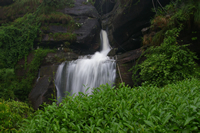previous session | next session

"Cliff tea" in the high mountain portion of the Wu Yi Moutain Region
http://www.wildchina.com/blog/tag/andrew-stein/
Session 19—Mon, Oct 10: Song China ①: Tea practices 1
Topics
❖ Introductory comments
◊ Tea cultivation
◊ Tealeaf crafting
❖ Imperial tribute tea
◊ Extra-country trade
Thoughts—read before class, revisit for tests
From the most general of perspectives, the 300 years or so of the Song dynasty saw many changes in tea at all levels. Among these of particular note the lead role that imperial patronage takes in enhancing, regulating and taxing tea cultivation and this, together with weakened Buddhist institutions, in some ways would seem to shift the focus from religious institutions to government ones. However, from our perspective, which is the regional developments of tea culture, tea as it is being developed within Buddhist institutions is the tea that Japanese visiting monks will encounter and learn and bring back to Japan in the late 1100s. Nevertheless, imperial patronage stimulates tealeaf crafting (in particular the imperial love for white tea, in a "true" powdered form—the powdered tea that will be the basis for the Japanese tea ceremony), tea cake making (smaller, more beauitful, with emboss designs an area of artistic competition), and tea contests (for selection as imperial tribute tea and for entertainment—imperial tribute tea competitions also stimulate teaware design including striking black ware meant to show off beauitfully the white froth of competition tea). The Jianzhou region of Fujian province becomes the preeminent tea-producing area. All imperial tributes teas are located somewhere in Fujian though tea is being produced in nearly all provinces of China by this time.
Widespread production and consumption of tea supports the full development of teahouses and it is in conjunction, in part, with the entertainment provided at these houses that important developments in Chinese literature and theater occur.
Required—to be completed for today's session
✓ Nothing.
Multimedia notes
❖ textextext
◊ textextext
Links
⇢ textextext
Other
Links to each session page
Jan 23, W S01
Jan 25, F S02
Jan 28, M S03
Jan 30, W S04
Feb 1, F S05
Feb 4, M S06
Feb 6, W S07
Feb 8, F S08
Feb 11, M S09
Feb 13, W S10
Feb 15, F
S11
Feb 19, W S12
Feb 21, F S13
Feb 25, M S14
Feb 27, W S15
Mar 1, F S16
Mar 4, M S17
Mar 6, W S18-Midterm
Mar 8, F S19
Mar 11, M S20
Mar 13, W S21
Mar 15, F
S22
Mar 18, M S23
Mar 20, W S24
Mar 22, F S25
Apr 1, M S26
Apr 3, W S27
Apr 5, F S28-Midterm
Apr 8, M S29
Apr 10, W S30
Apr 12, F S31
Apr 15, M S32
Apr 17, W S33
Apr 19, F
S34
Apr 22, M S35
Apr 24, W S36
Apr 26, F S37
Apr 29, M S38-Midterm
May 1, W S39
May 3, F S40
May 6, M (RRR)
May 8, W (RRR)
May 10, F (RRR)
May 14, Tu FINAL
